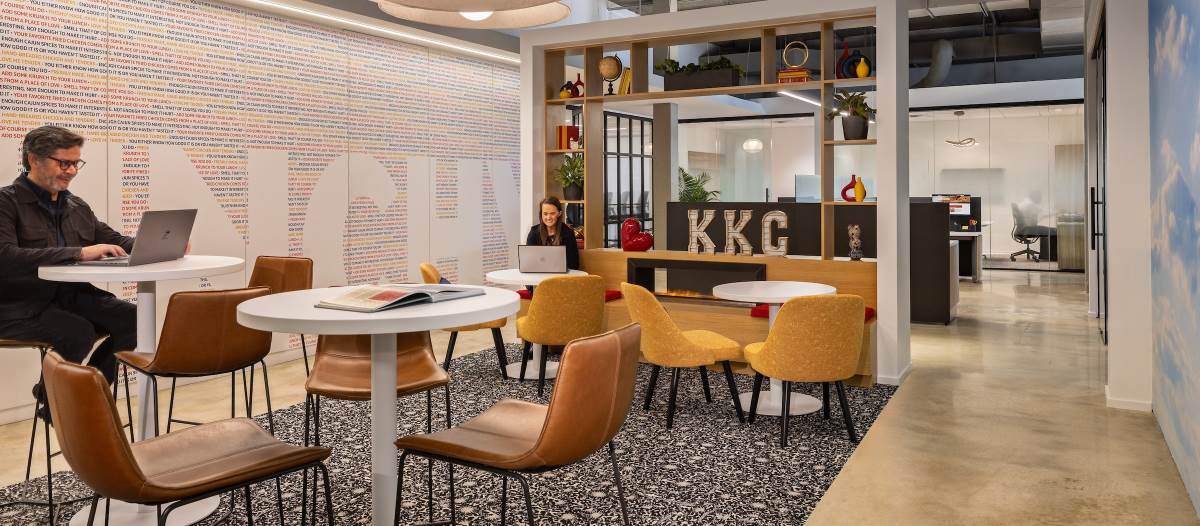The New-Age Meeting Room
Rethinking collaboration space

Imagining the workspaces of tomorrow typically lands dreamers in the realm of intelligent buildings. After all, they are the most likely outcome of global ambitions for sustainable spaces, efficient workforces and all things digital transformation.
Today’s conference room is the poster-child use case for intelligent building technology. It is a collaboration space for a hybrid workforce, a welcoming room for hosting guests-to-impress and an incubator for hatching the ideas of a firm’s best and brightest. As such, the conference room must be flexible, comfortable and perhaps most important, cohesively connected to the rest of the building and its occupants. Each of these must-haves is made possible by smart building devices, such as IoT sensors and actuators, all connected through cables that carry data through the same wires as energy.
But that is for today. What about tomorrow? How will the communal working spaces of tomorrow be shaped and reshaped to reflect the ways our future selves contribute to the world?
Network architecture will precede physical architecture
The most foundational shift expected in the design of the new-age meeting room resides in the personas of the designers themselves. Whereas today’s office blueprints often begin in the minds and AutoCAD modules of architects, tomorrow’s buildings will begin with technologists. Networking IT professionals will be the first to plan a commercial real estate project, mapping out the nodes, switches and protocols necessary for optimal performance of all things “smart.” This initial step will empower the architect to bring a big vision to life without compromising the efficacy of a client’s investment in intelligent spaces. This will also allow for the scalability of smart-building experiences for occupants as they move from room to room in a corporate office.
Hyper personalized comfort for individuals
Regarding occupants, the new-age meeting room will be equipped to identify and cater to the needs of everyone, whether they are joining remotely or in-person. The rapid advancement of authentication technology, like facial recognition, micro motion sensors, as well as retinal, fingerprint and palm scanners, provides a glimpse of what is to come. These same innovations, which were largely developed to confirm identity and prevent unauthorized access, are just as capable of enabling hyper personalized comfort.
Imagine arriving early for the meeting. While walking through the doorway, the conference room responds instantaneously. A smart chair is automatically set to the exact right height; the virtual conferencing camera is configured with the exact right filter and microphones set to the exact volume; the AC is turned up or down to achieve preferred temperatures. It is all happening without so much as the flip of a wall switch and based on choices either explicitly shared with the system, or the system has intuited through AI analysis of past behaviors and their outcomes.
Millions of data insights to augment FM expertise
Of course, the surveillance gadgets in the new-age meeting room will provide aggregate insight as readily as individualized comfort. Workplace facility managers will have real-time insight into the use of different spaces and features/functions of any conference room on the network. Millions of data points from thousands of devices will stream into their sphere, making it possible (with the help of AI) to not only know what is happening in the moment, but what will most likely happen in five minutes, five weeks or five months.
Even better, intelligent buildings’ predictive models will integrate with prescriptive counterparts, helping FMs and building owners reach their goals much more quickly and efficiently. For example, a new regulation goes into effect suddenly, placing a mandatory carbon cap on buildings of a certain size. FMs can augment their professional skill with the use of a prescriptive model, presenting the C-suite with options, including the expected outcomes and likely timeframes of each.
The machine will understand the pros and cons of, for instance, reducing employee access to HVAC settings, automatically closing smart shades on the west side of the building during certain hours or only sending hot water to specified floors or rooms on particular days. To mitigate the risk of an AI model making potentially catastrophic choices on its own, it will be crucial for FMs to maintain human-in-the-loop procedures as these technologies become integrated into their buildings.
Kudos to the ‘greenest meeting of the week’
Increasing societal prioritization of sustainability is likely to have a trickle-down impact on the new-age meeting room. That is because regulators are merely one stakeholder group focused on making buildings healthier for occupants and the environment. Employees also are becoming more aware of the carbon footprint of the companies they are thinking of joining. Intelligent buildings will accommodate a range of sustainably oriented behaviors, attracting top talent while also deputizing them in the pursuit of green ambitions.
This may include configurable settings on computing devices and smart furniture that let users in on the energy savings they “earn” each day. Imagine a gamified dashboard on the company intranet that posts digital kudos to the greenest meeting of the week or the most sustainable employee of the month. Maybe employees even earn points for their sustainable choices – rewards they can cash in for extra PTO or a lift to work from one of the self-driving vehicles in the company fleet.
Ethernet cables & the digital ceiling advance sustainability
Real estate owners looking to improve the sustainability of their properties will have more infrastructure options in the future. Rapidly advancing technology, like Power-over-Ethernet (PoE) cabling, is already creating exponentially more efficient spaces. Traditional electrical systems require the use of separate cables for data and power. PoE eliminates the need for separate cables, reducing the materials required and the waste generated. PoE technology is also more energy efficient than traditional electrical systems, as it reduces energy loss during transmission.
The set up is experiencing a vastly expanding set of uses cases, not the least of which are spaces for human collaboration. Given its visible nature, the conference room has proven to be one of the most popular places to install today’s iteration of the PoE “digital ceiling,” enabling owners to showcase the innovation while also experimenting with its scalability and outcomes.
Continuous learning about the productivity of proximity
Questions about the future of in-person work abound. Yet, the farther global society pulls back from the pandemic, the clearer it becomes that humans collaborate best in physical proximity. The new-age meeting room will reflect the lessons learned about productivity, creativity and employee satisfaction when colleagues experience work IRL.
The pandemic is just one of what are sure to be many teachable moments to come. Just think of what will happen when technologies like quantum computing challenge even our most basic notions about time and space. Will people even need to meet? Or will they simply meld our minds using brain-to-computer links and faster-than-light communication? Only time will tell.

Read more on Occupancy & Human Factors , Real Estate and Workplace
Explore All FMJ Topics









